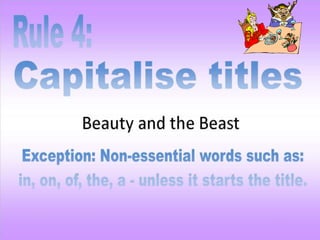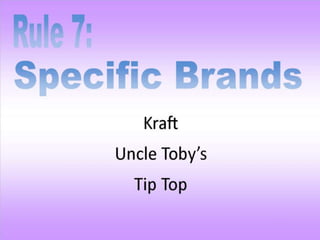1 of 12
Downloaded 51 times












Ad
Recommended
Adjectives
Adjectiveslindsaystewart1
╠²
This document provides an overview of different types of adjectives including describing adjectives, pointing adjectives, number adjectives, and possessive adjectives. It gives examples of each type and interactive exercises asking the reader to identify the specific adjective in examples. The purpose is to teach readers about the different categories of adjectives and how they are used to modify and provide more description and meaning to nouns.Some Kinds of Adjective with my Group in2011B, in Structure 2
Some Kinds of Adjective with my Group in2011B, in Structure 2STKIP PGRI Jombang
╠²
This document provides an overview of adjectives, categorizing them into types such as descriptive, limiting, numeral, demonstrative, proper, quantitative, interrogative, possessive, predicate, and distributive adjectives. Each type is defined with examples illustrating their usage in sentences. The document emphasizes the roles these adjectives play in modifying nouns and clarifying quantities, origins, and conditions.Adjective & types of Adjectives by Dilshad Hussain Shah Nikyalvi
Adjective & types of Adjectives by Dilshad Hussain Shah NikyalviDilshad Shah
╠²
This document defines and describes adjectives and adjectival phrases. It discusses the definition of adjectives, the different types of adjectives including determiners, the order of adjectives, the position of adjectives, degrees of adjectives including comparative and superlative forms, pre-modifiers that can intensify degrees of adjectives, and some examples of adjective usage. The document provides detailed information on adjectives and adjectival phrases in a technical linguistic context.Foundations of Grammar 6: What is an adjective?
Foundations of Grammar 6: What is an adjective?HUSS-Elearning
╠²
This document defines and provides examples of adjectives. It states that adjectives describe, identify, or quantify nouns and pronouns. Some common types of adjectives are descriptive adjectives, possessive adjectives, interrogative adjectives, and demonstrative adjectives. In English, adjectives typically precede the nouns they modify, but can also follow nouns with additional words between. Nouns can also sometimes function as adjectives to describe other nouns. The document notes that in some languages, adjectives have different forms depending on the gender and number of the noun they modify.Adjective
AdjectiveDr. Imran Khan
╠²
This document provides an overview of different types of adjectives in English grammar. It discusses 12 main types of adjectives: adjective of quality, adjective of quantity, adjective of number, demonstrative adjective, distributive adjective, interrogative adjective, possessive adjective, emphasizing adjective, exclamatory adjective, proper adjective. For each type, it provides the definition, examples, and how they are used attributively or predicatively in sentences. Key examples of different adjective types are given throughout to illustrate their meanings and uses.Parts of speech
Parts of speechK29091999V
╠²
The document provides an overview of the different parts of speech in English, including definitions and examples for nouns, pronouns, verbs, adjectives, adverbs, prepositions, conjunctions, interjections, and articles. It categorizes each part of speech into specific types, illustrating their functions within sentences. Additionally, it contains exercises to reinforce understanding of these concepts.Exclamation sentences &Interjection
Exclamation sentences &InterjectionAmirHoseyn
╠²
This document discusses exclamations and interjections in grammar. It defines exclamations as sentences used to express strong emotions like surprise or shock, often with an exclamation point. Common exclamation structures include those using "how" or "what". Examples are provided like "How beautifully she sings!" or "What amazing car!". Interjections are more common in speaking and express emotions briefly through sounds like "ouch" or "hooray". The document stresses that interjections are distinct from exclamations.Exclamatory Sentences!
Exclamatory Sentences!janet25
╠²
The document provides examples of using "so" and "such" to begin clauses describing something with an adjective or adverb. It shows how "so" is used with adjectives and adverbs to describe intensity, while "such" is used with nouns to describe quality or extent. Examples are given of each type of clause and answers provided for exercises choosing the correct word to complete sentences.Adjective
Adjectiveanhngockt90
╠²
The document defines adjectives and discusses their syntactic functions and classifications. It notes that adjectives modify nouns and outlines their positions before nouns, after verbs, and after objects. It also discusses attributive and predicative adjectives and subclasses like intensifying, limiter, and denominal adjectives. Verbless adjective clauses and semantic classifications of adjectives into stative, dynamic, gradable and inherent are also covered.Adjective presentation
Adjective presentationRENU PRIYA
╠²
This document defines and provides examples of the different types of adjectives in English. It discusses qualitative adjectives that describe qualities like color, size, age, etc. It also covers quantitative adjectives about numbers, demonstrative adjectives that point out nouns, possessive adjectives showing ownership, and others. The document explains how to make comparisons between adjectives and provides irregular forms. It concludes with examples of identifying adjectives in sentences.Microorganisms (3) (2)
Microorganisms (3) (2)Sudhanshu Kathuria
╠²
Microorganisms are tiny organisms that are too small to be seen with the naked eye. They can live in various environments ranging from ice cold climates to hot springs. Microorganisms include bacteria, fungi, protozoa, and some algae. Viruses are also considered microbes though they can only reproduce inside host cells. Some microorganisms are useful for producing medicines and alcohol, while others decompose organic waste and help clean the environment. However, some microorganisms can also cause diseases in humans, animals, and plants.Possessive nouns and possessive adjectives
Possessive nouns and possessive adjectivesIngles Corporativo
╠²
This document focuses on the grammar of possessive nouns and adjectives, explaining their usage and distinctions. It provides rules for forming singular and plural possessive nouns and introduces possessive adjectives as substitutes for possessive nouns. Additionally, it highlights common pitfalls, such as distinguishing between 'whose' and 'who's' in the context of possession.Comparative and Superlative Adjectives
Comparative and Superlative AdjectivesInterAmerican Academy
╠²
This document provides rules for forming comparative and superlative adjectives in English. It explains that comparative adjectives are used to compare two things and use endings like "-er" or "than". Superlative adjectives compare more than two things and use endings like "-est" or "the most". The rules provided give guidance on adding suffixes based on the number of syllables in the adjective and whether it ends in certain letter combinations. Exceptions for irregular adjectives are also noted. The purpose is to help readers properly form comparative and superlative adjectives.Kinds of adjectives
Kinds of adjectivesSelvi Raveendran
╠²
The document defines and provides examples of different types of adjectives: possessive adjectives indicate ownership, interrogative adjectives pose questions, demonstrative adjectives point out facts about nouns, adjectives ending in "-ing" describe with that quality, and adjectives ending in "-ed" indicate something that has undergone or been subjected to the action of the word. Examples are given for each type of adjective to illustrate their meanings and uses.adjective phrase
adjective phrasetranphuong91
╠²
The document summarizes different types of adjective phrases in English, including their structure and syntactic functions. It discusses:
- The typical structure of an adjective phrase includes a premodifier (adverb), head (adjective), and postmodifier (adverb or prepositional phrase).
- Adjectives can function as subject complements, noun pre-modifiers, postpositive modifiers, heads of noun phrases, and in verbless and contingent adjective clauses.
- Adjectives are classified as central if they can be both attributive and predicative, or attributive-only if restricted to modifying nouns.Adjectives - Their Types
Adjectives - Their TypesSri Prakash Vidya Niketan
╠²
The document discusses the different types of adjectives in English grammar. It defines adjectives as words that add description to nouns and pronouns. There are several kinds of adjectives, including adjectives of quality, quantity, number, distributive adjectives, demonstrative adjectives, possessive adjectives, participial adjectives, interrogative adjectives, and exclamatory adjectives. Each type is defined and examples are provided. The document serves as a guide to the classification of adjectives according to their function.Comparative adjectives
Comparative adjectivesAna Escuadra Cana
╠²
This document provides examples of comparative adjectives by listing items or concepts and the adjectives that could be used to compare them. Some of the comparisons include trainers, shoes, superheroes, fish, jewelry, rivers, streets, and exams using adjectives like old, new, comfortable, strong, weak, powerful, ugly, beautiful, colourful, expensive, cheap, long, short, clean, dirty, noisy, quiet, peaceful, exciting, boring, dangerous, safe, easy, and difficult.Comparative Adjectives
Comparative AdjectivesSarah Tanti
╠²
The document discusses adding -er to adjectives to make comparisons. It provides examples of adding -er to long lists of adjectives like "tall", "hot", and "kind". It then provides example sentences comparing two things using the comparative adjectives, such as "Andrew is much taller than Derek" and "The church is higher than our house".Comparatives and Superlatives
Comparatives and Superlativesguest1c532f7
╠²
This document provides information about adjectives, comparative adjectives, and superlative adjectives in English. It defines what adjectives are and provides examples of one, two, and three syllable adjectives. It explains how to form comparative adjectives by adding "-er" or "-more" and irregular forms. It also explains how to form superlative adjectives by adding "-est" or using "the most" and lists irregular forms. Examples are given to demonstrate comparative and superlative forms.Comparative superlative-1
Comparative superlative-1Mehmet Y─▒ld─▒r─▒m
╠²
The document discusses comparative and superlative adjectives. Comparative adjectives compare two objects or people, and are formed by adding "-er" or "more" depending on the adjective. Superlative adjectives compare one object or person to a group, and are formed by adding "the -est" or "the most" depending on the adjective. There are five rules for forming comparatives and superlatives regularly, as well as irregular forms that must be memorized.Possessive Adjectives
Possessive AdjectivesIrenya S
╠²
This document discusses possessive adjectives in English and provides examples of their use. It lists the personal possessive pronouns and their corresponding adjectives in both singular and plural forms. Examples are then given showing the adjectives being used to indicate possession, such as "This is MY house" and "He is on the beach with HIS dog". The purpose is to illustrate how possessive adjectives are used to show ownership or possession of nouns in a sentence.Comparative and Superlative adjectives
Comparative and Superlative adjectivesDitza Graca
╠²
The document discusses comparative and superlative adjectives. Comparatives are used to compare two objects, like saying "the Ford is bigger than the Toyota." Superlatives compare more than two objects, like saying "the Ford is the biggest." There are five basic rules for forming comparatives and superlatives: adding "-er" or "-est"; doubling consonants; removing "y" and adding "-ier" or "-iest"; adding "more"; and exceptions for common adjectives.Adjective powerpoint
Adjective powerpointpam_chastain
╠²
The document provides guidance for identifying adjectives by explaining that adjectives describe nouns by answering what kind, which one, or how many. It emphasizes finding the nouns in a sentence first before identifying the adjectives that describe attributes of the nouns, such as what kind, which one, or how many. Several examples are given to demonstrate finding the nouns and then identifying the adjectives that describe them.Interrogative sentences,adverbs,adjectives, pronouns
Interrogative sentences,adverbs,adjectives, pronounsSwayam SJ
╠²
This document discusses different types of interrogative words in English including interrogative sentences, adverbs, adjectives, and pronouns. It provides examples of each type. Interrogative sentences are questions that use helping verbs like "does" and "are". Interrogative adverbs ask about time, place, manner, quantity or reason using words like "how", "when", and "why". Interrogative adjectives include words like "which" and "what" used along with nouns. Interrogative pronouns are words like "who", "whose", and "what" used to ask questions. Finally, it lists common wh-words in English and provides examples of questions using them.Fractions for year 3
Fractions for year 3Sally Marland Bush
╠²
1. Fractions represent parts of a whole that is divided into equal parts. A fraction has a numerator above a denominator, where the numerator tells how many parts are being considered and the denominator tells how many parts make the whole.
2. Fractions can be represented on a number line, where each increment represents another equal part of the whole. Common fractions include halves, thirds, and quarters.
3. Fractions are used in everyday situations like baking, where recipes call for measurements like 1/4 cup of an ingredient. They help describe portions or percentages of a whole object or quantity.Reference list
Reference listSally Marland Bush
╠²
This document contains a reference list of 6 sources: 3 from the Australian Curriculum, Assessment and Reporting Authority website about the science, ICT, and critical thinking curriculums. The other 3 are YouTube videos from 2008, 2012, and 2012 about classification of living things and an animal song.Reference list
Reference listSally Marland Bush
╠²
This document contains a reference list of 5 sources from the Australian Curriculum and Assessment Reporting Authority and other online sources about science, ICT capabilities, critical thinking, and classification of living things and an animal song video. The references are from 2013 to 2015 and are from the ACARA website and YouTube.A note to teachers
A note to teachersSally Marland Bush
╠²
This resource provides information and activities for year 3 students on classifying animals according to observable features. It explores features of living things like animals and shows how to categorize them in a Venn diagram. The resource covers content on identifying living things, predicting patterns, and representing data. It also demonstrates use of technology and digital sources. The learning objectives are for students to identify animal features, classify animals, and present comparisons. The resource uses explicit teaching, worksheets, engaging videos and music, and demonstrations like a Venn diagram.More Related Content
Viewers also liked (17)
Adjective
Adjectiveanhngockt90
╠²
The document defines adjectives and discusses their syntactic functions and classifications. It notes that adjectives modify nouns and outlines their positions before nouns, after verbs, and after objects. It also discusses attributive and predicative adjectives and subclasses like intensifying, limiter, and denominal adjectives. Verbless adjective clauses and semantic classifications of adjectives into stative, dynamic, gradable and inherent are also covered.Adjective presentation
Adjective presentationRENU PRIYA
╠²
This document defines and provides examples of the different types of adjectives in English. It discusses qualitative adjectives that describe qualities like color, size, age, etc. It also covers quantitative adjectives about numbers, demonstrative adjectives that point out nouns, possessive adjectives showing ownership, and others. The document explains how to make comparisons between adjectives and provides irregular forms. It concludes with examples of identifying adjectives in sentences.Microorganisms (3) (2)
Microorganisms (3) (2)Sudhanshu Kathuria
╠²
Microorganisms are tiny organisms that are too small to be seen with the naked eye. They can live in various environments ranging from ice cold climates to hot springs. Microorganisms include bacteria, fungi, protozoa, and some algae. Viruses are also considered microbes though they can only reproduce inside host cells. Some microorganisms are useful for producing medicines and alcohol, while others decompose organic waste and help clean the environment. However, some microorganisms can also cause diseases in humans, animals, and plants.Possessive nouns and possessive adjectives
Possessive nouns and possessive adjectivesIngles Corporativo
╠²
This document focuses on the grammar of possessive nouns and adjectives, explaining their usage and distinctions. It provides rules for forming singular and plural possessive nouns and introduces possessive adjectives as substitutes for possessive nouns. Additionally, it highlights common pitfalls, such as distinguishing between 'whose' and 'who's' in the context of possession.Comparative and Superlative Adjectives
Comparative and Superlative AdjectivesInterAmerican Academy
╠²
This document provides rules for forming comparative and superlative adjectives in English. It explains that comparative adjectives are used to compare two things and use endings like "-er" or "than". Superlative adjectives compare more than two things and use endings like "-est" or "the most". The rules provided give guidance on adding suffixes based on the number of syllables in the adjective and whether it ends in certain letter combinations. Exceptions for irregular adjectives are also noted. The purpose is to help readers properly form comparative and superlative adjectives.Kinds of adjectives
Kinds of adjectivesSelvi Raveendran
╠²
The document defines and provides examples of different types of adjectives: possessive adjectives indicate ownership, interrogative adjectives pose questions, demonstrative adjectives point out facts about nouns, adjectives ending in "-ing" describe with that quality, and adjectives ending in "-ed" indicate something that has undergone or been subjected to the action of the word. Examples are given for each type of adjective to illustrate their meanings and uses.adjective phrase
adjective phrasetranphuong91
╠²
The document summarizes different types of adjective phrases in English, including their structure and syntactic functions. It discusses:
- The typical structure of an adjective phrase includes a premodifier (adverb), head (adjective), and postmodifier (adverb or prepositional phrase).
- Adjectives can function as subject complements, noun pre-modifiers, postpositive modifiers, heads of noun phrases, and in verbless and contingent adjective clauses.
- Adjectives are classified as central if they can be both attributive and predicative, or attributive-only if restricted to modifying nouns.Adjectives - Their Types
Adjectives - Their TypesSri Prakash Vidya Niketan
╠²
The document discusses the different types of adjectives in English grammar. It defines adjectives as words that add description to nouns and pronouns. There are several kinds of adjectives, including adjectives of quality, quantity, number, distributive adjectives, demonstrative adjectives, possessive adjectives, participial adjectives, interrogative adjectives, and exclamatory adjectives. Each type is defined and examples are provided. The document serves as a guide to the classification of adjectives according to their function.Comparative adjectives
Comparative adjectivesAna Escuadra Cana
╠²
This document provides examples of comparative adjectives by listing items or concepts and the adjectives that could be used to compare them. Some of the comparisons include trainers, shoes, superheroes, fish, jewelry, rivers, streets, and exams using adjectives like old, new, comfortable, strong, weak, powerful, ugly, beautiful, colourful, expensive, cheap, long, short, clean, dirty, noisy, quiet, peaceful, exciting, boring, dangerous, safe, easy, and difficult.Comparative Adjectives
Comparative AdjectivesSarah Tanti
╠²
The document discusses adding -er to adjectives to make comparisons. It provides examples of adding -er to long lists of adjectives like "tall", "hot", and "kind". It then provides example sentences comparing two things using the comparative adjectives, such as "Andrew is much taller than Derek" and "The church is higher than our house".Comparatives and Superlatives
Comparatives and Superlativesguest1c532f7
╠²
This document provides information about adjectives, comparative adjectives, and superlative adjectives in English. It defines what adjectives are and provides examples of one, two, and three syllable adjectives. It explains how to form comparative adjectives by adding "-er" or "-more" and irregular forms. It also explains how to form superlative adjectives by adding "-est" or using "the most" and lists irregular forms. Examples are given to demonstrate comparative and superlative forms.Comparative superlative-1
Comparative superlative-1Mehmet Y─▒ld─▒r─▒m
╠²
The document discusses comparative and superlative adjectives. Comparative adjectives compare two objects or people, and are formed by adding "-er" or "more" depending on the adjective. Superlative adjectives compare one object or person to a group, and are formed by adding "the -est" or "the most" depending on the adjective. There are five rules for forming comparatives and superlatives regularly, as well as irregular forms that must be memorized.Possessive Adjectives
Possessive AdjectivesIrenya S
╠²
This document discusses possessive adjectives in English and provides examples of their use. It lists the personal possessive pronouns and their corresponding adjectives in both singular and plural forms. Examples are then given showing the adjectives being used to indicate possession, such as "This is MY house" and "He is on the beach with HIS dog". The purpose is to illustrate how possessive adjectives are used to show ownership or possession of nouns in a sentence.Comparative and Superlative adjectives
Comparative and Superlative adjectivesDitza Graca
╠²
The document discusses comparative and superlative adjectives. Comparatives are used to compare two objects, like saying "the Ford is bigger than the Toyota." Superlatives compare more than two objects, like saying "the Ford is the biggest." There are five basic rules for forming comparatives and superlatives: adding "-er" or "-est"; doubling consonants; removing "y" and adding "-ier" or "-iest"; adding "more"; and exceptions for common adjectives.Adjective powerpoint
Adjective powerpointpam_chastain
╠²
The document provides guidance for identifying adjectives by explaining that adjectives describe nouns by answering what kind, which one, or how many. It emphasizes finding the nouns in a sentence first before identifying the adjectives that describe attributes of the nouns, such as what kind, which one, or how many. Several examples are given to demonstrate finding the nouns and then identifying the adjectives that describe them.Interrogative sentences,adverbs,adjectives, pronouns
Interrogative sentences,adverbs,adjectives, pronounsSwayam SJ
╠²
This document discusses different types of interrogative words in English including interrogative sentences, adverbs, adjectives, and pronouns. It provides examples of each type. Interrogative sentences are questions that use helping verbs like "does" and "are". Interrogative adverbs ask about time, place, manner, quantity or reason using words like "how", "when", and "why". Interrogative adjectives include words like "which" and "what" used along with nouns. Interrogative pronouns are words like "who", "whose", and "what" used to ask questions. Finally, it lists common wh-words in English and provides examples of questions using them.More from Sally Marland Bush (9)
Fractions for year 3
Fractions for year 3Sally Marland Bush
╠²
1. Fractions represent parts of a whole that is divided into equal parts. A fraction has a numerator above a denominator, where the numerator tells how many parts are being considered and the denominator tells how many parts make the whole.
2. Fractions can be represented on a number line, where each increment represents another equal part of the whole. Common fractions include halves, thirds, and quarters.
3. Fractions are used in everyday situations like baking, where recipes call for measurements like 1/4 cup of an ingredient. They help describe portions or percentages of a whole object or quantity.Reference list
Reference listSally Marland Bush
╠²
This document contains a reference list of 6 sources: 3 from the Australian Curriculum, Assessment and Reporting Authority website about the science, ICT, and critical thinking curriculums. The other 3 are YouTube videos from 2008, 2012, and 2012 about classification of living things and an animal song.Reference list
Reference listSally Marland Bush
╠²
This document contains a reference list of 5 sources from the Australian Curriculum and Assessment Reporting Authority and other online sources about science, ICT capabilities, critical thinking, and classification of living things and an animal song video. The references are from 2013 to 2015 and are from the ACARA website and YouTube.A note to teachers
A note to teachersSally Marland Bush
╠²
This resource provides information and activities for year 3 students on classifying animals according to observable features. It explores features of living things like animals and shows how to categorize them in a Venn diagram. The resource covers content on identifying living things, predicting patterns, and representing data. It also demonstrates use of technology and digital sources. The learning objectives are for students to identify animal features, classify animals, and present comparisons. The resource uses explicit teaching, worksheets, engaging videos and music, and demonstrations like a Venn diagram.Features of animals.ppsx
Features of animals.ppsxSally Marland Bush
╠²
The document distinguishes between living things based on their skeletal structure. Invertebrates lack a backbone, while vertebrates possess one. This classification helps in understanding different species.Categorising animals
Categorising animalsSally Marland Bush
╠²
The document discusses the categorization of animals based on their features, particularly comparing dogs and ducks. It utilizes a Venn diagram to illustrate common and unique characteristics of each animal, such as four legs and a backbone for dogs, and two legs and feathers for ducks. The goal is to recognize patterns and similarities that help in understanding animal classification.Features of Living Things
Features of Living ThingsSally Marland Bush
╠²
The document discusses various features of animals as living things, including their physical traits like fur and feathers, the number of legs, and methods of breathing. It also categorizes animals into carnivores and herbivores based on their diet, and describes their habitats and behavioral patterns such as nocturnality and diurnality. Additionally, the document mentions reproductive methods like laying eggs or giving live birth and highlights the ability of some animals to camouflage.Examining the Features of Living Things
Examining the Features of Living ThingsSally Marland Bush
╠²
The document discusses the diverse features of animals, highlighting characteristics such as body coverings (fur, feathers), limb counts, respiratory methods (lungs, gills), and dietary preferences (carnivores, herbivores). It also mentions various habitats (land, water) and behavioral patterns (nocturnal, diurnal). The document encourages readers to think of additional features of living things.Ad
Editor's Notes
- #13: Reference Listmrstanbro1. (2012, March 20). When Do I Use Capital Letters? [Video file]. Retrieved from http://www.youtube.com/watch?v=_dwYgQMqBLI
